- Stretching can ease the aging process by helping with joint pain, mobility, flexibility and posture.
- Stretching may also help with balance, coordination, muscle control and blood circulation.
- It’s recommended that seniors should try to stretch each major muscle group for at least 10-minutes a day, two days a week, at a minimum.
Aging is a natural part of life, but there are ways to slow this process by taking care of your body. Stretching and exercising can play a major role in how your body ages and your mobility. Stretching can help to improve flexibility, posture, and can ease joint pain that naturally comes along with aging. Keeping fit as you age can help make daily tasks easier, even something as simple as standing up from a chair or pulling yourself out of bed.
A simple stretching routine can have major impact on how you feel in your body, so follow along as we breakdown the impact of stretching on aging as well as a variety of simple stretches that can help slow the aging process.
Impact of Stretching on Aging
Stretching can ease the aging process and help allow for greater movement in the joints and improve posture, according to Healthline. Keeping up a consistent stretching routine can also help to release muscle tension and soreness, and reduce the risk of falling or injury. Stretching may help with balance, coordination, muscle control and blood circulation as well.
A study published in the Journal of Gerontology analyzed the 12-month results of a stretching program for older adults. The results showed that participants experienced a decrease in pain and positive changes in their overall well-being, physical fitness, efficacy and perceived functioning.
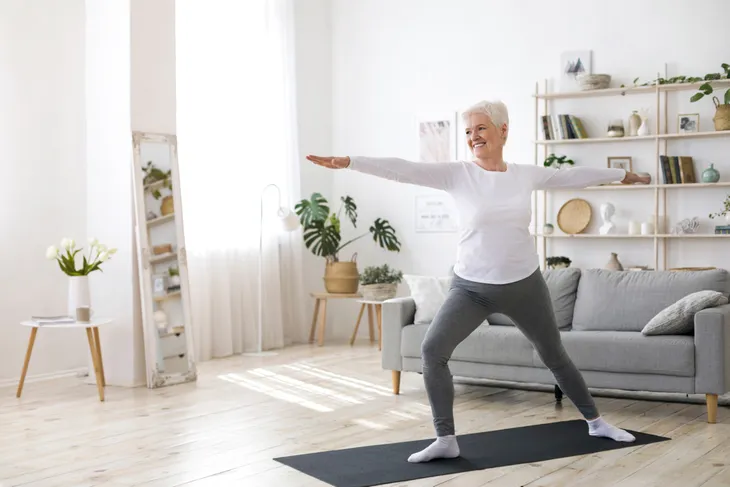 Shutterstock/Prostock-studio
Shutterstock/Prostock-studioStretching Guidelines
Finding the time and energy to stretch each day can be overwhelming, but it may help to incorporate it into your morning or nighttime routine. You could also incorporate stretching at the beginning or end of your exercise program, even if it’s just a gentle stretch routine at the end of a walk. You should try to always perform your stretching routine following any cardiovascular or resistance training, if possible.
According to Healthline, it’s recommended that seniors should try to stretch each major muscle group for at least 10-minutes a day, two days a week, at a minimum. If you’re able to incorporate stretching into your daily routine, however, you’ll see even quicker and further improvement in mobility, posture and pain.
 Shutterstock/wavebreakmedia
Shutterstock/wavebreakmediaStretching Tips
When it comes to stretching, there are a few basic tips that can help along the way. Be sure to always take deep breaths and slowly exhale as you stretch. It’s also important to hold each stretch for at least 15 to 30-seconds to give your muscles enough time to fully relax and release.
While leaning into a stretch may feel good, it’s important to know your limit. Only stretch until you feel tension in the muscle, but never to the point where you feel pain. If you’re feeling extra tight, it may help to warm up before stretching by moving around for a few minutes or going for a walk. This can warm up your muscles and allow you to get even deeper into the stretches.
 Shutterstock/kudla
Shutterstock/kudlaNeck Stretch
There are a variety of stretches that seniors can perform to improve mobility, but it is important to focus on areas that hold a lot of tension. One area in particular that tends to be quite tight is our neck muscles. Maintaining mobility of the neck is important for posture and many daily tasks.
An easy way to stretch the neck is to slowly bring your ear towards your shoulder. You can also hold the position with your arm for extra support and resistance. Hold the position for 15-seconds and then switch sides.
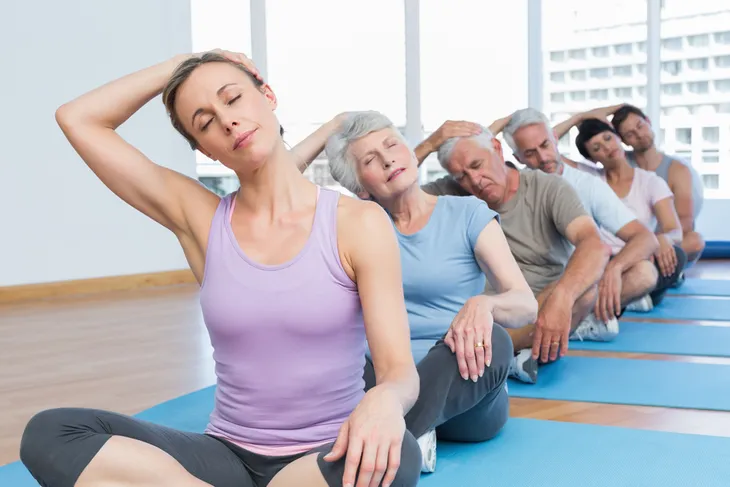 Shutterstock/wavebreakmedia
Shutterstock/wavebreakmediaShoulder and Upper Arm Stretch
Similar to the neck, our upper arms and shoulders tend to hold a lot of tension, especially as our shoulders slouch as we get older. According to Healthline, keeping our shoulders mobile is important as we age to maintain independence in simple activities such as getting dressed or reaching for items off a shelf.
A great stretch for the upper arms and shoulders is to reach one hand over the head and attempt to grasp it with your other one until you feel a stretch. It’s recommended to use a towel to assist in this stretch. Reach behind your head with one arm and allow the towel to drape down between your head and back, then reach for the end of the towel with your other hand until you feel a stretch.
 Shutterstock/Prostock-studio
Shutterstock/Prostock-studioOverhead Side Stretch
Another great upper body stretch is the overhead side stretch. This stretch is a great way to open up and loosen the abdomen, back and shoulders. It will improve posture and flexibility and can be performed both seated or standing.
To perform this stretch, lift one arm over your head and gently lean in the opposite direction while keeping your core engaged and torso long. Hold this stretch for 15-seconds and repeat on the other side.
 Shutterstock/michaeljung
Shutterstock/michaeljungHamstring Stretch
When it comes to lower body, a common area of tightness and tension is the hamstrings. If you struggle with tight hamstrings, especially as an older adult, you may struggle with lower back pain of experience difficulty walking.
To perform a hamstring stretch, begin by lying on your back and extending one leg perpendicular to your body. Grasp your extended leg on the back of your thigh and slowly bring the legs towards you. Be sure to keep your other leg and hip on the ground while performing this stretch. Hold for 15 to 30-seconds and repeat on each side.
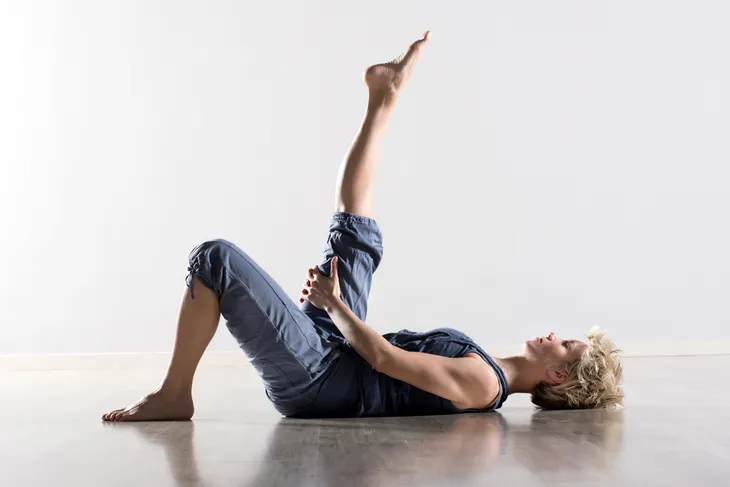 Shutterstock/Photology1971
Shutterstock/Photology1971Ankle Stretch
Having poor mobility in your ankles can lead to difficulty in many basic areas of your life, including walking and getting up and down. It’s important to maintain ankle flexibility since the ankles play an important role in balance and coordination.
To perform an ankle stretch, you can sit in a chair or sit with your legs outstretched on the ground. Move your ankle in circles, up and down and side to side for 30-seconds, and then repeat on the other foot.
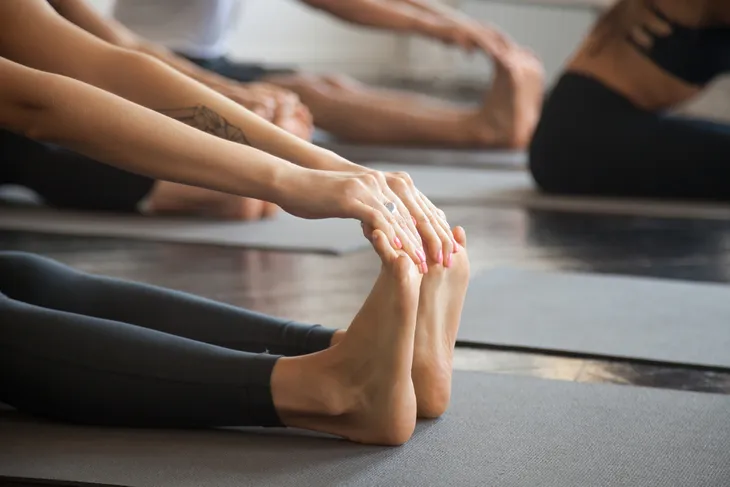 Shutterstock/fizkes
Shutterstock/fizkesHip Stretch
Healthline explains that it’s common for older adults, and especially women, to hold tension in their hips. Tight hips can cause postural imbalances as well as issues in the lower back, knees and sacroiliac joints. There are many ways to stretch the hips, but a good gentle one is a lunge stretch.
To perform this stretch, kneel in a lunge position with both knees at a 90-degree angle. Lean forward until you feel a stretch in your hip flexor. You can hold this position for a few seconds or gently rock in and out of this stretch to loosen your hip flexor. To intensify this stretch, you could reach your arms upwards and look towards the sky.
 Shutterstock/Inspiring
Shutterstock/InspiringQuadriceps Stretch
Similar to your hips, your quadriceps are a group of large muscles on the front of your thigh. If your quads become tight, you may struggle with daily activities such as walking and standing. It’s common for quads to become tight if you tend to sit a lot, but this makes it that much more important to be sure to stretch them.
To perform a quad stretch, start by standing and bend your foot behind you by holding it with your hand. Ensure that your knees stay aligned and keep you core engaged. For extra support, you can also hold a chair or wall while performing this stretch. You can also use a belt or towel for assistance if you cannot reach your foot.
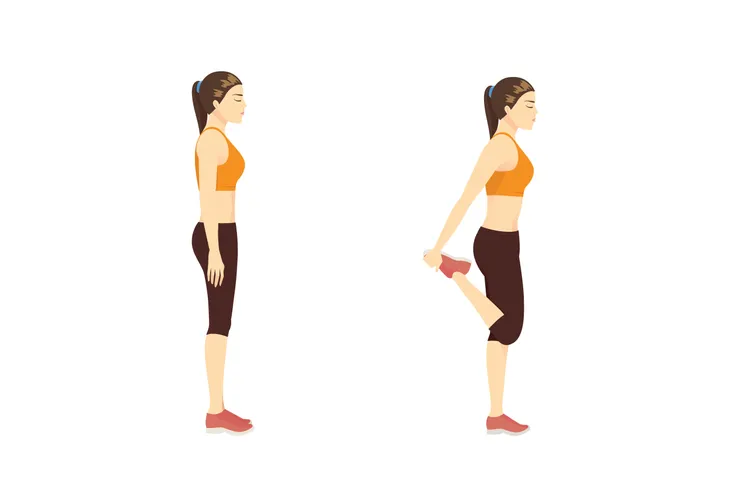 Shutterstock/solar22
Shutterstock/solar22Lower Back Stretch
Back pain can be common as we age, so it’s important to be preventative with stretches to keep our postural muscles and back strong. Your spine plays a huge role in posture, so it’s crucial to maintain mobility in this area.
A gentle way to stretch your lower back is through performing child’s pose. To begin this stretch, sit with your knees curled and fold at your hip until your head reaches the floor. Stretch your arms forward and hold the pose until you feel a release in your lower back. You could also rotate reaching your arms out to each side to release tension from the sides of your lower back.
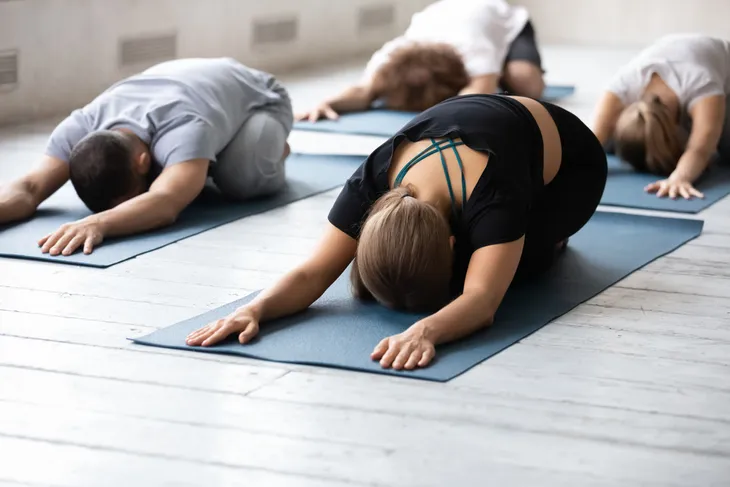 Shutterstock/fizkes
Shutterstock/fizkesWhat to Do Beyond Stretching
While stretching itself can help improve mobility and lessen pain, it’s also important to take care of your body and health in other ways as we age. Cardiovascular activities and resistance training help strengthen and support your bones and muscles, which can keep you feeling young and mobile.
Proper hydration and diet are also important to help older adults maintain overall health. According to Better Health While Aging, experts generally recommend that older adults consume at least 1.7-liters of fluid per day. In terms of diet, be sure to eat plenty of vegetables and fruits, whole grain foods and protein.
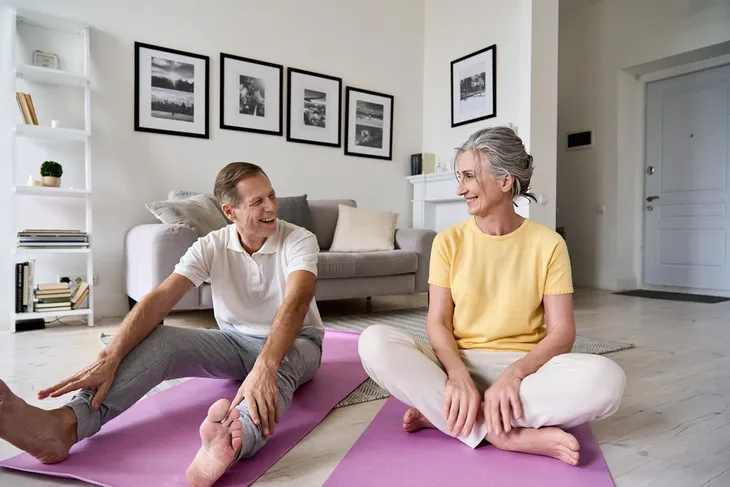 Shutterstock/insta_photos
Shutterstock/insta_photos


